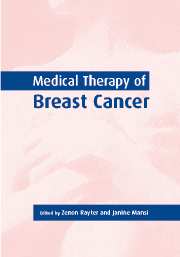Book contents
- Frontmatter
- Contents
- List of contributors
- 1 History of breast cancer therapy
- 2 Chemoprevention of breast cancer
- 3 Familial breast cancer
- 4 Hormone replacement therapy and breast cancer
- 5 Screening for breast cancer
- 6 The management of in situ breast cancer
- 7 Adjuvant systemic therapy
- 8 Adjuvant radiotherapy in the management of breast cancer
- 9 Predictors of response and resistance to medical therapy
- 10 Primary medical therapy in breast cancer
- 11 Medical therapy of advanced disease
- 12 Experimental approaches
- 13 The place of bisphosphonates in the management of breast cancer
- 14 Palliative care in breast cancer
- Index
5 - Screening for breast cancer
Published online by Cambridge University Press: 06 January 2010
- Frontmatter
- Contents
- List of contributors
- 1 History of breast cancer therapy
- 2 Chemoprevention of breast cancer
- 3 Familial breast cancer
- 4 Hormone replacement therapy and breast cancer
- 5 Screening for breast cancer
- 6 The management of in situ breast cancer
- 7 Adjuvant systemic therapy
- 8 Adjuvant radiotherapy in the management of breast cancer
- 9 Predictors of response and resistance to medical therapy
- 10 Primary medical therapy in breast cancer
- 11 Medical therapy of advanced disease
- 12 Experimental approaches
- 13 The place of bisphosphonates in the management of breast cancer
- 14 Palliative care in breast cancer
- Index
Summary
Introduction
Screening is the application of diagnostic measures to an apparently healthy population in the hope of uncovering serious disease at an early stage when treatment is more likely to be curative than it is at a later stage. A number of countries have national programmes providing mammographic screening for breast cancer, these include the UK, Finland, Sweden, Netherlands and Australia. In other countries such as the USA widespread mammographic screening activity follows national guidance. This chapter describes the basis for breast screening as well as current practice and potential future developments.
Why screen?
The purpose of screening is to reduce the mortality from breast cancer. The value of regular screening in doing this for women over 50 has been demonstrated by randomized controlled trials.
There are a number of risk factors related to breast cancer (see Table 5.1). The strongest risk factors are being female and an older age. Most of the well-established risk factors for breast cancer are not modifiable. Unlike the association between smoking and lung cancer there is no single major cause of breast cancer that can be easily avoided.
Treatment for breast cancer, both local and systemic shows success rates closely linked to the stage of the cancer at presentation (Figure 5.1). (Cancer Research Campaign, 1996). Patients with small tumours which are less than 2 cm in diameter have a greater than 90% chance of surviving 5 years compared with 60% for patients with tumours over 5 cm in diameter. Involvement of axillary nodes indicates a worse prognosis (Miller et al., 1995).
- Type
- Chapter
- Information
- Medical Therapy of Breast Cancer , pp. 103 - 125Publisher: Cambridge University PressPrint publication year: 2003



